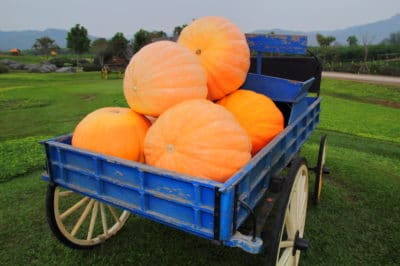Types of Giant Pumpkins
In the pumpkin world, only pumpkins that are larger than 150 pounds (68 kilograms) qualify for the title of a giant. Some pumpkins can even grow to weight as much as 1000 pounds (454 kilograms).
Although many conventional varieties of pumpkins grow to be quite large, only certain kinds of seeds produce the actual giant pumpkin. Some of these varieties include Dills’s Atlantic Giant and Big Moose varieties.
Tip: It is best to purchase a well-known variety of pumpkin seed labeled explicitly as a Giant Pumpkin. Otherwise, you will not be able to grow a pumpkin that qualifies as a real giant.
How to Plant a Giant Pumpkin
Planting a giant pumpkin follows the same necessary steps as planting any other pumpkin [ink u=how-to-plant-pumpkin-seeds]seed[/link]. However, gardeners have the best chance of success by beginning preparations in the fall, proper to planned planting time.
Amend Soil Appropriately
Since giant pumpkins take up a lot of room and require additional fertilizer to grow to such gargantuan proportions, it is essential to enrich the soil in the area you plan to plant.
Plan in the fall by clearing out a large area and adding a thick layer of mulch-from 3-5 ft (0.9-1.5 meters)-on top of the ground where you are planting. Leaves and manure work best for this, but if you do not compost your own materials, a commercial organic compost will also work.
Using Cover Crops to Enrich Soil and Control Weeds
A cover crop such as rye, hard white wheat or millet can also enrich the soil as well as help control weeds. These crops are planted in the fall and tilled under in the spring, adding much-needed nitrogen to the land.
Cover crops also help control weeds by crowding out weed seeds and preventing them from taking over. Cover crops are essential for organic growers because they limit the need for weed killers.
Starting Giant Pumpkin Seeds Indoors
To give the Giant Pumpkin plants a head start on the growing season, savvy gardeners start the seeds indoors about four weeks before the last forecasted frost date. By doing so, you can be sure the plants are well-established and healthy before planting the pumpkin sprouts into the ground.
Additionally, Giant Pumpkin varieties do require a longer growing season than traditional pumpkins, anywhere from 130 to 165 days depending on the variety. Starting seeds indoors is a must in order to provide the plants the growing time they need to reach monstrous proportions.
Tip: Use peat pots to start the seeds indoors. The pots can be planted directly into the ground when they are ready, which is easier plus prevents the root from becoming stressed.
After transplanting, be sure to provide cover from the wind and possible late frosts by creating mini-greenhouses for the pumpkin plants. Some materials used for these include:
- Plastic milk jugs with the bottoms cut out.
- Plastic sheeting such as is used to cover windows.
- Small plastic buckets.
Nurturing Giant Pumpkins
Once the pumpkin plants have begun to thrive, continue with regular feeding and watering. As soon as the vines start producing fruits, choose two or three of the biggest ones and cut the rest off at the vine. Pruning the plants allows more nutrients and energy to go directly to the choicest pumpkins, enabling them to grow even more significantly.
If you follow these directions and take care to provide ample sunshine, fertilizer, and water to the plants, harvest time should bring some of the most enormous pumpkin plants you have seen. If you are lucky, you could even win a prize at the local fair!
